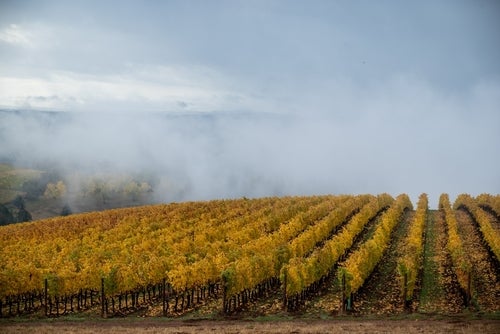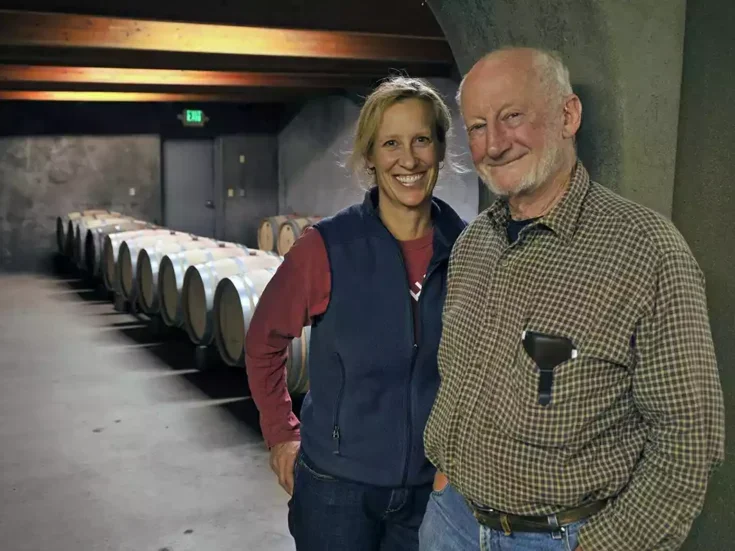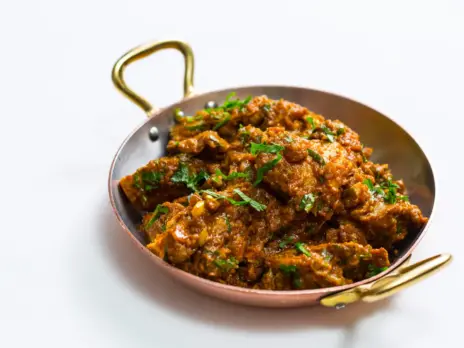
Andrew Jefford introduces a tasting of Oregon Pinot Noir shared with Anthony Rose and David Williams.
Early 2025 will mark 60 years since David Lett first planted Pinot Noir in Oregon’s Willamette Valley. They weren’t the state’s first Pinot plantings—those took root in 1961 farther south, in the Umpqua Valley; while wine vines in general (notably “Klevner”) have been grown in the state since the 1880s. Few 20th-century planting gestures have been as significant as Lett’s, though. “Papa Pinot” famously claimed that he’d been hit by “a cosmic brick” during his winetasting classes at the University of California, Davis, a bolide dense with the disorientating seductions of red Burgundy. After graduation and a 1964 European research tour, he arrived (against the advice of his Davis professors) in Willamette “with 3,000 vines and a theory.” He rooted the cuttings in a rented nursery block, then went out hunting for suitable land. Eyrie Vineyards in the Dundee Hills was established in 1966.
The theory has held; the cosmic brick, hurtling forward in spacetime, has blossomed into a meteor shower. In 2022, Oregon had some 18,010ha (44,487 acres) of vineyards, with more than two thirds of those (12,522ha [30,929 acres]) in Willamette. Almost 60% of the planted state acreage is Pinot Noir, and that proportion is even higher in Willamette: around 67%. The Valley and its 11 nested AVA subregions occupy a propitious West Coast “Middle Earth” for Pinot: cloudy, temperate, mild. You don’t get the savage winter chills of Washington State or British Columbia in Willamette; nor do you get the lavish summer warmth that increasingly characterizes California’s Pinot grounds. Pinot clearly enjoys Willamette’s complex soils, based on marine sediments, basalt, loess, and Missoula-flood deposits; limestone is not necessary to produce beautiful, shapely wines from this cultivar.
The number of wineries increased fivefold in the first two decades of the 21st century—and the economic model for these tends to follow the small-scale Burgundy blueprint; some 70% of Oregon wineries currently produce less than 5,000 cases a year. There’s a quality emphasis. Oregon may account for less than 1% of US domestic production, but it still managed (for example) to win 23% of the “Top 100” wine slots selected by Wine Spectator critics in 2021. Oregon wines’ average retail price is comfortably above that achieved by either California or Washington State ($17.10 in 2021, compared with $10.46 and $8.15 respectively).
Oregon Pinot Noir: Affability and more
Our three tasters were all enthusiastic about the Oregon Pinot Noirs we surveyed, and this tasting was successful, with the top 25 wines (out of 45) all scoring an aggregate of 90 points or above. Scores of 93 or above equate to “Outstanding wine of great beauty and articulacy,” according to the World of Fine Wine rubric. Our most enthusiastic taster—David Williams—found no fewer than ten wines meriting 93 points and two meriting 94 and 95. Anthony Rose noted four wines on 93 and two each on 94 and 95, while I had five wines on 93 with one each on 94 and 95. David drew attention to the “consistent ripeness sweet spot” of these “alluringly fleshy but fluent wines,” which managed to avoid the pitching between over- and under-ripeness typical of non-Burgundian Pinot elsewhere. Anthony Rose, too, admired their consistency, though he chose to highlight their “excellent fragrance, freshness, energy, and charming drinkability, closer in style to red Burgundy than any other Pinot Noir region I can think of.”
Both comments imply affability—and this is what I would underline. There wasn’t a single difficult or forbidding wine in the top half of our entry, and those that did disappoint in the lower half generally did so due to over-exuberance with oak or with fruit expression, or because of a lack of purity or precision. The finest wines, meanwhile, conveyed compelling aromatic complexity married to impressive depth and structure—a combination rare outside Burgundy. They are wines to spend time over, and wines for gastronomic partnerships, too. You will generally get a little more in the mouth from Oregon Pinot than you will from the Côte d’Or or the Côte Chalonnaise, and its textures will be a little softer—but Oregon is elsewhere, and this should be so. The Pinot ideal of tenderness, intricacy, and grace is rarely betrayed here. It was noticeable, indeed, that even among the lower-scoring wines there was generally one out of our three tasters with clear enthusiasm for the wine in question—the play of enthusiasm was more subjective in this tasting than for most. There’s a huge amount on offer.
All sub-regions can excel
Could we draw any conclusions about sub-regions from the tasting? The fact that there were 14 wines from the breezy Eola-Amity AVA (sited in southern Willamette) compared with significantly fewer samples from other sub-regions, surely told its own story, and this sample imbalance makes conclusions about sub-region tentative at best, if not thoroughly unreliable. Let’s try, though—for fun if nothing else. Excluding the four bottom-placed wines (all of which had queries over character and condition) as well as the five wines without a sub-regional AVA, gives us an aggregate score for each sub-region of 276.33 for Yamhill-Carlton (three samples only), 272.85 for Eola-Amity, and 271.60 for Laurelwood. Dundee Hills (two samples only) scored 270.50 and tiny Ribbon Ridge 270. The three wines sold under the Chehalem Mountains AVA (which includes both Laurelwood and Ribbon Ridge) aggregated 269.66, while there was a single sample each from Tualatin Hills (274) and McMinnville (271). At this stage of Willamette evolution, it would seem as if all of these sub-regions can excel—but, as Anthony Rose pointed out, six of the 11 top places is certainly encouragement for Eola-Amity. Particular congratulations, finally, to Ken Pahlow and Erica Landon’s team at Walter Scott, who took the two top places in our blind tasting, exceeding their previous double top-ten showing in our last Oregon Chardonnay tasting (see WFW 79, 2023, pp.210–17).






